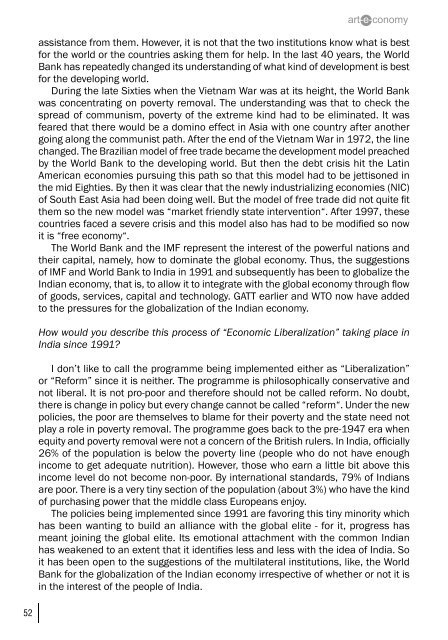art-e-conomy _ reader - marko stamenkovic
art-e-conomy _ reader - marko stamenkovic
art-e-conomy _ reader - marko stamenkovic
Create successful ePaper yourself
Turn your PDF publications into a flip-book with our unique Google optimized e-Paper software.
52<br />
assistance from them. However, it is not that the two institutions know what is best<br />
for the world or the countries asking them for help. In the last 40 years, the World<br />
Bank has repeatedly changed its understanding of what kind of development is best<br />
for the developing world.<br />
During the late Sixties when the Vietnam War was at its height, the World Bank<br />
was concentrating on poverty removal. The understanding was that to check the<br />
spread of communism, poverty of the extreme kind had to be eliminated. It was<br />
feared that there would be a domino effect in Asia with one country after another<br />
going along the communist path. After the end of the Vietnam War in 1972, the line<br />
changed. The Brazilian model of free trade became the development model preached<br />
by the World Bank to the developing world. But then the debt crisis hit the Latin<br />
American economies pursuing this path so that this model had to be jettisoned in<br />
the mid Eighties. By then it was clear that the newly industrializing economies (NIC)<br />
of South East Asia had been doing well. But the model of free trade did not quite fit<br />
them so the new model was “market friendly state intervention“. After 1997, these<br />
countries faced a severe crisis and this model also has had to be modified so now<br />
it is “free e<strong>conomy</strong>“.<br />
The World Bank and the IMF represent the interest of the powerful nations and<br />
their capital, namely, how to dominate the global e<strong>conomy</strong>. Thus, the suggestions<br />
of IMF and World Bank to India in 1991 and subsequently has been to globalize the<br />
Indian e<strong>conomy</strong>, that is, to allow it to integrate with the global e<strong>conomy</strong> through flow<br />
of goods, services, capital and technology. GATT earlier and WTO now have added<br />
to the pressures for the globalization of the Indian e<strong>conomy</strong>.<br />
How would you describe this process of “Economic Liberalization” taking place in<br />
India since 1991?<br />
I don’t like to call the programme being implemented either as “Liberalization”<br />
or “Reform” since it is neither. The programme is philosophically conservative and<br />
not liberal. It is not pro-poor and therefore should not be called reform. No doubt,<br />
there is change in policy but every change cannot be called “reform“. Under the new<br />
policies, the poor are themselves to blame for their poverty and the state need not<br />
play a role in poverty removal. The programme goes back to the pre-1947 era when<br />
equity and poverty removal were not a concern of the British rulers. In India, officially<br />
26% of the population is below the poverty line (people who do not have enough<br />
income to get adequate nutrition). However, those who earn a little bit above this<br />
income level do not become non-poor. By international standards, 79% of Indians<br />
are poor. There is a very tiny section of the population (about 3%) who have the kind<br />
of purchasing power that the middle class Europeans enjoy.<br />
The policies being implemented since 1991 are favoring this tiny minority which<br />
has been wanting to build an alliance with the global elite - for it, progress has<br />
meant joining the global elite. Its emotional attachment with the common Indian<br />
has weakened to an extent that it identifies less and less with the idea of India. So<br />
it has been open to the suggestions of the multilateral institutions, like, the World<br />
Bank for the globalization of the Indian e<strong>conomy</strong> irrespective of whether or not it is<br />
in the interest of the people of India.


